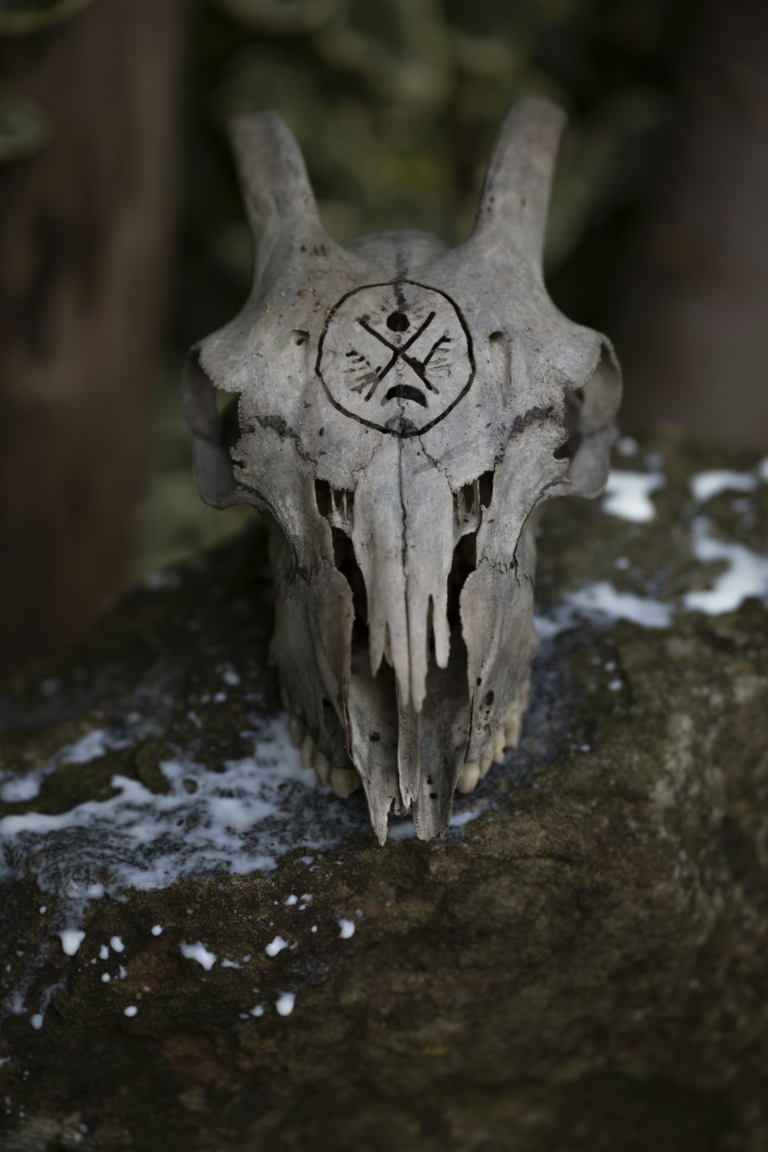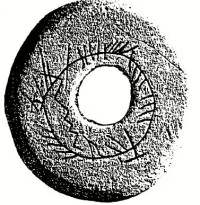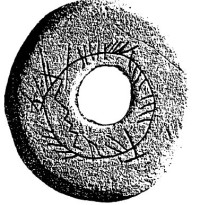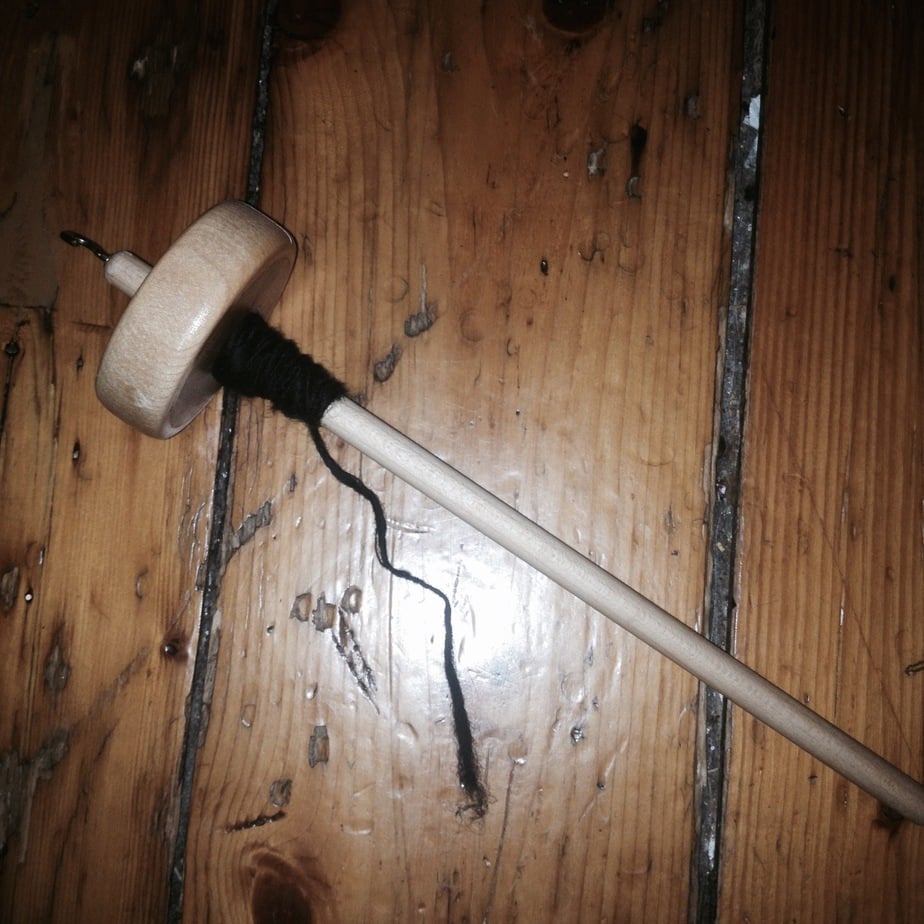
Newsletter Subscribe
Enter your email address below and subscribe to our newsletter

Enter your email address below and subscribe to our newsletter


Exploring Scottish Folk Practices and Traditions

Island Spinning Song

Hullamackadoo, hooravahee
Hoorovahinda, hoorovahinda,
Hullamackadoo, hooravahee,
O dicko-o-deck-o-dandy
When will someone come to me?
Will he come by land or sea
Will he my own lover be?
O, tell me truly, wheel.
Wheel o’ fate what is’t you say?
This year, next, or ne’er a day?
When will a wooer come my way?
O, tell me truly, wheel.
Be he dark or be he fair,
Shy or bold or debonair,
Ribbons braw will deck my hair
To meet and greet my true love.
(Traditional Scottish spinning song [1])
We hear a lot about cauldrons, besoms, and crystal balls and black cats, anthems, stangs etc in practice but I have never encountered much literature or witnessed praxis based on the use of spinning and its associated skills.
It is the importance of the tool to the practice you work, its personal significance to your self that makes an item sacred, not how rare and shiny it is or how you brought from a website to perform a certain task and special to only one occasion, a tool should be used not revered. We don’t often read or hear people speak very much about the use of spinning in forms of the craft. A lot of modern discussion is based on arable cycles, and areas where plants and wheat/corn are important but if you come from a pastoral or poor landed area like Scotland, where livestock were more important we should be focus on our own practice and rituals with wool: spinning, knitting, dyeing and knotting.
Scottish folk sung a lot whilst working and certain types of song were used for different occasions. The above spinning song is an example of a working song, such as used for lots of tasks in Scotland from rowing, waulking, milking, weaving and spinning. They are singing as they spin about which love will come to them and who they may be, a song to the threads of fate if you will. Songs such as these were not only sung alone but also sung in public, in the form of question answer verse’s and chorus. The beat and lyrics not only formed the basis of songs ensuring people could keep in time for the task at hand but also provided a means of ensuring intention and attention was maintained. Spinning was vital to Scotland and other Gaelic cultures and it still has a booming trade in places such as Hawick. Spinning, however, dates back a very long time and the original spinning, before the invention of the spinning wheel and its subsequent industrialisation was carried out by the use of the distaff and spindle.
A spindle is constructed of a round weight, a whorl, and a stick that goes through the middle of it, a spindle. Around this central stick and whorl the fibres come together to make thread. This practice is essentially magical in itself and doesn’t require much imagination on how it could be used, especially in accompanying the task with a suitable song.
Archaeologist have found a large number of whorls buried with people from across Scotland and points to its fundamental use within Gaelic culture. Some of these have been discovered with blessings carved into them in Ogham writing. An example of this was found in Orkney in 1995 [2], engraved with a translation that could be “blessings on the soul of L” depending on how its translated. This would move deosil (sunwise), meaning as the thread was spun the spinner could read the words. A powerful way of reminding the person what they were spinning for perhaps? or maybe as it spun the “prayer” would be released in a ne’er ending cycle into the world, a bit like a Tibetan prayer wheel? Or perhaps it let the spirits know what the spinning was for or perhaps it was just a gift named for the spinner. Who knows.
Genealogists also talk of the distaff side of the family, being the female side. The word spinster, (originating from spinner?) is still a legal term for an unmarried women. Spinning and its associated culture is embedded within our language and Scottish culture. For these reasons spinning is something that should be re-embraced within Scottish craft and magical practices.

Here you can see my very own simple drop spindle. This is what is known as a top spindle but you can also use a bottom spindle. If you would like to know more about how to spin there are many excellent tutorials on youtube. I have picked out one below for you that shows you the ease in which you can spin without using a distaff.
The symbology and personal relationship with the tool is very important, as with all practices that relate to folk magic. The whorl and the spindle come apart, and it could be viewed as representing the male (spindle stick) and female (whorl) elements in certain practices. There are also a number of Scottish tales related to spinning including characters such as Habetrot, The Cailleach and the Gyre Carling. It was tradition to ensure that your spinning and roving was removed from the spindle before and distaff on hogmanay (New Year) least it be taken. So spinning directly relates to these figures Scottish folk tales in regards the action of these figures at this time of year.Why? Perhaps of it wasn’t removed they would come and remove the threads of your families fate, bestowing a not very good year to follow. The Cailleach was also a figure of Sovereignty and somewhat like the Norns would have held the fate of others and the land. So spinning thread becomes like weaving the threads of fate. (You can read more about the Cailleach and Habetrot in other posts).
As already mentioned the act of spinning can be done with intention maintained throughout the process. This ensures your intention is woven into the thread. Intention could be ensured by singing a song as was done traditionally or maintaining intention in your usual way based on your own practice.
The choice of roving used might also be considered as important. If you were creating something in your practice that was for healing or protection then you might want to use a natural substance like sheep wool roving that has been died red or blue perhaps. You would also ensure that the spindle moved sun-wise or deosil. You could easily reverse this, spinning widdershins (anti clockwise) with an appropriate coloured roving if you wanted to remove something or create something that was to be baneful in its use.
Spinning by itself also has a fantastic way of allowing your mind to relax, that is once you have got the hang of it. It can be a bit stressful starting out but you soon get into a flow of working and it becomes an automatic action allowing you to go into a trance like state.
Heres a short step by step process taken from the amazing and gifted spinning lecture given by Jennifer Lauxman (PhD) [3] based just outside Glasgow, Scotland. She uses a method not unlike mine but i prefer the word emotion or spirit blessing to intention
1) Begin with purpose in mind – Make a habit of declaring your intention before you begin. Bring your mind to the present act rather than multi tasking and letting your mind wander while you set up tools. ( I would also say a short prayer to the spirits at this point and write the purpose on the whorl).
2) Prepare your operative space and tools with care be mindful and intentional. There is nothing more distracting if you have to stop and go collect something you have forgotten.
3) Use the structure of your belief and practice to set the space. Use preparation rituals and prayers of your belief to set this period of time aside for your spinning.
4) The mind can be fluid and even the best of intention of focus can ebb and flow. When you notice yourself being distracted be gentle with yourself. Do not cause a huge rift in your focus by getting angry with yourself. Rather pause your spinning, close your eyes, deep breath and refocus. [This is why I sing a song or hum as you spin but the choice is yours, it also let the spirits know why you’re doing what you’re doing ed].
5) When you have finished your work you can make a formal closing. Acknowledge the work you have done and what its purpose was for and that you have finished for that period of time. (Leave a wee offering to the spirits. ed)
So now you have magically spun thread what can you do with it? You can use any form of other knitting craft that you may know to then perhaps knit it into a garment, crochet into something or use a lucet to create a chord to be worn. There are groups of weavers and spinners who make clothes for babies who have been taken away from this world to soon. Perhaps you could work in a group to combine your efforts. The uses are pretty endless.
Lucet with red dyed Wool – creating chord for hanging Rowan CrossesYou can also use the single thread, minus the knitting or weaving if you don’t have the skills for this, to tie around body parts you wish to heal or add into a the construction of protective charms, (such as a rowan cross), for your household, car or a person. It was very common to use blue threads in Traditional Scottish Folk magic to tie around a women as they were giving birth to ease the labour for instance. The uses are only as limited as your imagination and you can rest assured that whatever you choose to use it for its based in very old and far reaching folk lore and craft practices.
References:
[1] National Collegiate Chorale of Scotland (national.c.c.o.s)
[2] Forsyth (1995) Theogham-inscribed spindle-whorl from Buckquoy: evidence the Irish language in pre-Viking Orkney?. Proc. Soc. Antiq. Scot. Pp677-696.
[3] Jennifer Luaxman can be contacted at this website http://www.fairyspindles.com. She runs amazing workshops and has a lot more knowledge on spinning to share.
This is a really thorough article on a topic that is touched upon by many . Thank you! Having the practical skill along with the history and bringing it to today is really helpful. Spinning is part of so many European cultures and all of them link it with fate and magic . Suddenly I wonder why so few pagans included in their magical tools . It makes a lot more sense than expensive things no one’s ancestor would’ve been able to afford. The line between magic and “doing life” never was there at least on the level that so many today have drawn it . I love learning about the patterns in the Scottish fisherman sweaters , and the different songs that were sung to protect him. Because today people often multitask and have trouble with focusing, we don’t really have a culture where you can do something repetitious as your actual work that allows that trancelike state . Living off the grid Ifound it was a lot easier because there is so little distraction and physical labor that has to be done to survive . So if you aren’t being mindful you can cut your hand off or fall through ice , and with multiple chemical sensitivity all of my fabric and clothing have to be the purest organic possible so they are of course very expensive and cost something like it probably would’ve cost my family in the past , so you take care of things differently when you don’t have the money for things to be disposable , so darning socks and things like that , they bring back that sense of in the world magic . Grounded in your body and the singing or chanting is grounding in a different way and it is sustained for a while . I always prefer to learn about things in context so if I’m going to learn about knot magic which usually has to do with the weather then I’m going to study sailing knots. ( the Irish Sea has claimed the lives of enough of my ancestors, the fishing side of my family and my father has always been obsessed with sailing .) I think this is the most complete post I’ve seen on spinning , it’s really accessible . I would say write a book but you covered everything so succinctly!!! Thank you. It’s really exciting to learn something new .
I’ve been reading a book about the combination of Norse and Gaelic words by the way so this Spindle makes total sense. The Norse influence in Scotland is pretty heavy obviously especially the north. Ireland has begun really embracing the Viking heritage . I think with Europe becoming so much more multicultural it’s freeing up peoples minds to their own past . Even the 100 year anniversary this Easter for the rebellion people in Ireland talked about how children were killed and that isn’t something even 15 years ago you were supposed to say . It’s great that this idea of “purity” is gone about Celtic places, as much as it’s great that it’s gone about Scandinavian or Slavic . The DNA of Iceland shows the female side to be 50% matching Scotland and Ireland , from the very beginning . Considering how sailing was always the best way to travel around Britain, the idea of cultures being isolated is very strange . Especially when you look in the burials and it’s stuff from other places that the wealthy take with them , human beings love novelty . So seeing an actual visual image of two cultures that became a different culture is really great , thank you.
Thank you for a very informative article. Reminds me of a passage in E Barber’s book ‘Women’s work – the first 20,00 years’ which describes a ‘magical cloth’ where the warps and weft were twisted S and Z in groups of nine. Also Marion Bradley’s ‘ Mists of Avalon’ in which a destructive spell is woven into a cloak. I was fortunate when visiting the Shetland some years back to acquire a couple of spindle whorls from the soapstone quarries at Catspund – this has been in use since early times – some of the bowls made were unearthed at Old Scatness, which was being excavated at the time.
How lovely Michelle, just have a simple drop spindle but yours sound amazing! Making clothes for our family and friends must be some of the oldest magic
They had Time Team there at Old Scatness and one of them was making the spindle whorls. What was so lovely was that an 11 year old girl came up with her mum. She had gone to the quarry (not easy to find!) found a bit of soapstone and roughed out her own spindle whorl. The guy there put a polish on it for her and it was indistinguishable from the ones they were selling! Also nearby at Virkie Pool they found holes in the rock for posts to hold woollen handspun sails so that they could be fulled by the wave action. Imagine having to spin an entire suit of sails! yet this must have been the case right up until the 1800s. Nowhere have I been able to find reference to this – another case of womens’ work being taken for granted….
yes, you raise a great point about the sails. Ive never thought about what they would have been made out of before. Also how amazing and simple to make the whorl just as things should be. What a great story thanks for sharing 🙂
There is a fantastic book called The Spindle Hearth by Kate Dooley. It doesn’t use spindle magic but it’s about the pagan tradition of the Norse, Frigg(a) the mother goddess is a spinner.
I use spinning for meditation and for many spellcrafts, after I spin the wool with the spell held in the twist of the yarn, I use knot magic in the knitting or crochet of a gift for others, or a piece for myself. Protection and healing into hats for friends, kindness in mittens for children. The best part is, when I dye and blend my wools, I can customize the ultimate yarn by adding in gold for fortune, silk for strength, etc.
We do a lot of cord magic, so it’s really a joy to start out with a wool from a breed known for a trait (Cotswold for heartiness, merino for gentleness, Rambulet for fearlessness), dye the wool in a significant color, and spin the wool with spells to aid in the ultimate cord magic, then make the cord on a Lucent.